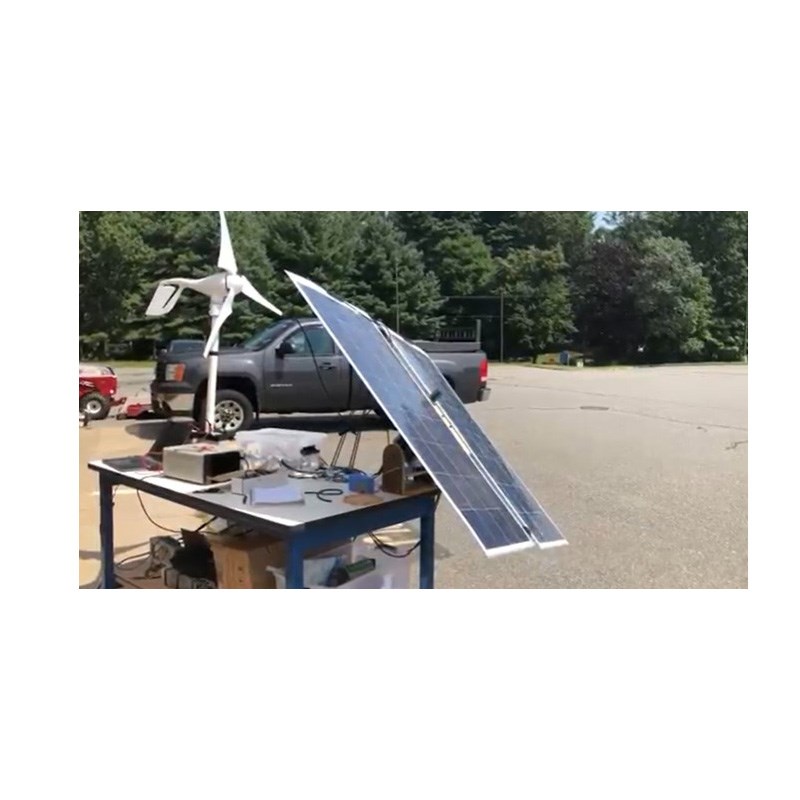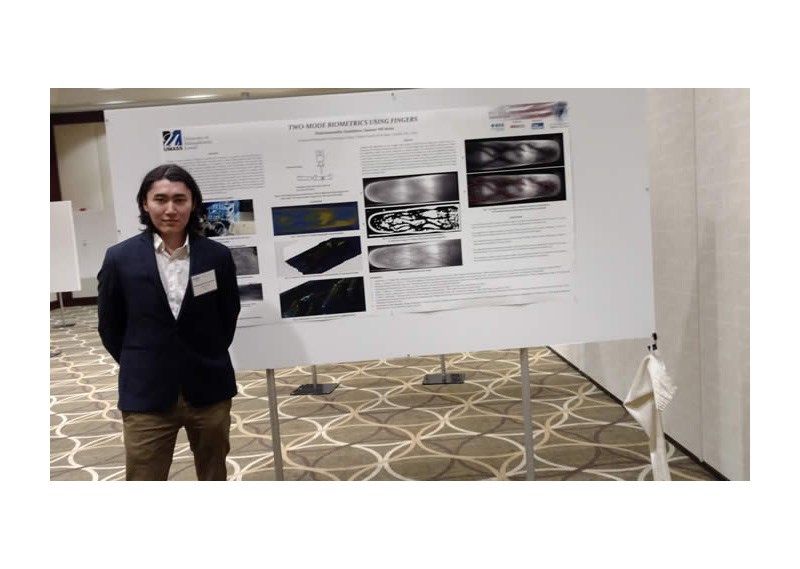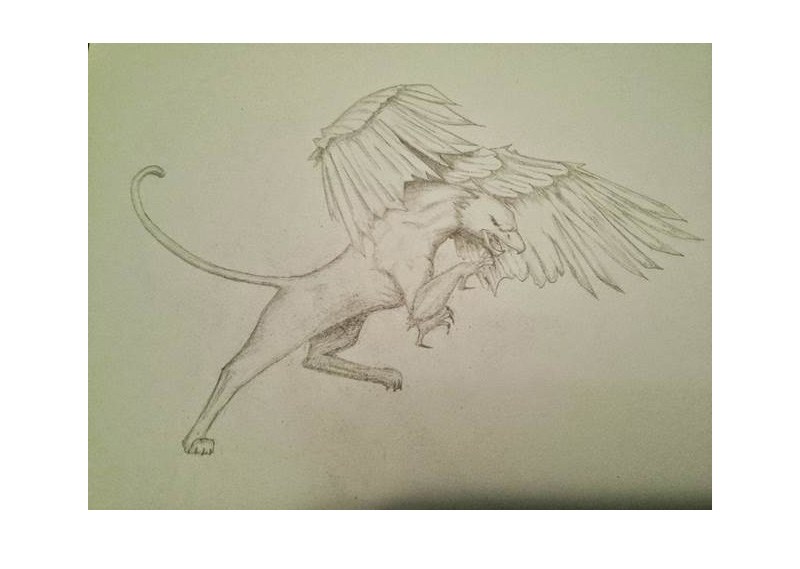Equipment Is Sustainable, Environmentally Friendly
Each weekend, an estimated 54 million Americans mow their lawns, consuming about 800 million gallons of gasoline every year and producing tons of air pollutants. According to the U.S. Environmental Protection Agency (EPA), lawn mowers (like snow blowers, chain saws, leaf blowers and similar gas-powered garden equipment) emit high levels of carbon monoxide, a colorless, odorless, poisonous gas.
“They also emit hydrocarbons and nitrogen oxides, pollutants that contribute to the formation of ozone,” states an EPA report. “While ozone occurs naturally in the upper atmosphere and shields the earth from harmful radiation, ozone at ground level is a noxious pollutant. Ground-level ozone impairs lung function, inhibits plant growth and is a key ingredient of smog.”
Samuel Hamill, a senior electrical engineering student from Lawrence, has created a prototype solar-powered push mower to help cut down on air pollution, gas consumption and noise. “It’s a sustainable, environmentally friendly way of maintaining one’s lawn,” says Hamill, who is scheduled to graduate in May.
His design is part of his capstone project, with Prof. Samson Mil’shtein as faculty adviser. Alan Rux of the Assistive Technology Program supervises all the senior capstone projects.
Hamill’s solar panel generates up to 160 watts, enough to power two small DC motors — one for driving the blades of a regular reel mower to cut grass and the other for turning the solar panel. A pair of photoresistors helps the panel keep track of the sun as the mower moves back and forth across the lawn.
“You don’t need a storage battery to operate the mower,” explains Hamill. “It will run directly off the solar panel. But you can certainly add a battery if you want to mow on a cloudy day. On a sunny day, the panel can run the mower and recharge the battery at the same time.”
AETC Staff Get Married
Winter usually brings pandemic of flu, cold in head and other viruses. However in December 2011 some of AETC students were bitten by a new virus; they married one after another.
In the month of December two AETC graduate students from India were married: Anup Pillai married Kavitha and Vishal Kunnil married Neeraja were married.
More December 2011 News
The month of December did bring another pleasant event for AETC. Doctoral student, John Palma, who graduated in the spring semester 2011, became the Professor - lecturer John Palma at our ECE department. There are already two ECE faculty, Joel Therrien (now Associate Professor) and John Palma who did their graduate studies with AETC. We wish John Palma successful professional career.
Pillai and McPherson Attend 2011 IEEE Homeland Security Conference
Doctoral student A. Pillai and undergraduate student C. McPherson of the ECE Dept. attended the 2011 IEEE Homeland Security Conference held at Westin Hotel, Waltham, MA. They were demonstrating a contactless handheld fingerprinting system as well as a network protocol secured by using biometrics. The IEEE Conference on Technologies for Homeland Security (IEEE HST) is the leading international conference addressing the challenges of homeland security technology innovation gaps. Since conception, this annual conference has gained prominence and recognition for bringing together science and technology leaders from around the world.
The demonstration was attended by big crowd of conference participants. The leading technology experts did positively comment the novel work being done by students at the Advanced Electronic Technology Center, UML ECE Dept.
Doctoral Student Anup Pillai Speaks at LDSD 2011, Mexico
Doctoral student Anup Pillai recently attended the International Conference on Low Dimensional Structures and Devices. The conference was held at Telchac, Nuevo Yucatan, Mexico from May 22nd-May 27th, 2011. Anup was giving an oral presentation and also presenting two posters. When asked about his experience at the conference, he had the following to say:-
The conference provided a forum for researchers, engineers, and product development. In addition, the conference also provided me an opportunity to get a broad overview of the field by covering a wide range of growth techniques, materials, nanostructures, characterization, processing, device fabrication, microsystems, applications, and other related topics. It was an indispensable experience as LDSD 2011 was my first international conference outside of United States. This quantum electronic conference had surprisingly large number of solar energy conversion presentations. This indicated to me that a lot of interest is being generated and research is being done in the solar energy conversion area around the world. I also got to experience the Mexican heat and also had a wonderful and a memorable visit to Chechen Itza.
Researchers Develop Superfast Computer Chip
Processor Can Make PCs 20 Times Faster
Frustrated with slow computers? Tired of waiting for your files to download? Researchers from the University of Glasgow in Scotland and UMass Lowell have created a new processor that will pave the way for superfast desktop PCs. This technology will be a boon especially for users who work with vast amounts of data, play video games or do heavy graphic editing. “Our processor’s performance, or data throughput, is five gigabytes per second, which is about 20 times faster than microprocessors currently in the market,” says Assoc. Prof. Martin Margala of UMass Lowell’s Electrical and Computer Engineering Department. Margala worked on the project along with Ph.D. student Sai Rahul Chalamalasetti.
Margala says the team was able to achieve this breakthrough by squeezing more than 1,000 cores onto the computer chip, called a Field Programmable Gate Array (FPGA). The core is the part of a computer’s central processing unit (CPU) that reads and executes commands. For comparison, today’s PCs have only two, four or 16 cores.
“We were able to make the FPGA processor run faster by creating more than 1,000 mini-circuits within the FPGA chip,” says Margala. “This effectively turned the chip into a 1,000-core processor, with each core performing a different task.”
In addition to enhanced processing speed, the new chip design consumes very little energy, so it represents a “greener,” more environmentally friendly option.
Although the work is still in an early, proof-of-concept stage, Margala believes that FPGA processors will become more widely used in consumer electronics and will help usher in a new era of high-speed computing.
ECE Students Attend Inventor Conference
On Feb. 5, 2010, six members of Prof. Sam Mil’shtein group (AETC), Vishal Oliyil Kunnil, Paula Bustos, Michael Paradis, Michael Baier, Michael Moore, and Josh Northrup, participated at the Invention to Venture workshop sponsored but the National Collegiate Inventors and Innovators Alliance (NCIIA) at the Microsoft NERD Center in Cambridge, MA. This was the first event of a series of workshops that introduces university students-inventors and entrepreneurs to the opportunities of funding and commercialization of their invention. The students made a splash after pitching their “Mobile Contactless Fingerprinting and Blood Vessel Mapping System”, and were asked by NCIIA coordinators to return in April to compete for the promise of commercialization and investor backed funding. When asked about their experience, the students relied that they were grateful for the opportunity to compete and that the opportunity to speak with venture capitalists and established entrepreneurs was a great learning experience, especially for those whose future plans are to have their own businesses. The AETC team was the biggest student group among students from different Massachusetts’s universities and colleges (MIT, Boston University, UMass campuses, and others). In April the AETC team is planning to present to investors three projects ready for commercialization, namely, a mobile fingerprint system; credit card and ATM crime preventing electronics with biometric signature; and a method of reducingelectronic waste generated by computers.
Bustos Receives Special Scholarship
Graduate student Paula Bustos attended the HENAAC Conference organized by the Great Minds in STEM organization. The HENAAC conference focuses on identifying, honoring and documenting the contributions of outstanding Hispanic American in science, engineering, technology and math. They are dedicated to highlight Hispanic talent in the United States. This is the third time Bustos attended the conference. The HENAAC conference was a great opportunity to meet professionals who have succeeded in the STEM field. Bustos networked with professionals from companies such as Lockheed Martin, Boeing, Chevron, Ford, NASA, Raytheon, Northrop Grumman, and more. As well, Bustos was able to network with other engineering students in the United States. She met people from MIT, Penn State, Cal Pomona, and Florida International University. As a scholarship recipient by Booz Allen Hamilton, Bustos is very thankful for the opportunity to attend the HENAAC conference and meet the Hispanic community in the STEM field. This conference does not only highlight the Hispanic talent but also looks to inspire future generations. After three days of extensive work, Great Minds in STEM gave away World Disney passes to the HENAAC attendees. Bustos went to Disney World for the first time.
Collaborations
AETC-STL (Submillimeter-wave Technology Lab) Project: Photomixing and Detection Applications using BDT (Ballistic Deflection Transistor) technology
The project will be jointly managed by Prof. Margala of AETC and Dr. Guy DeMartinis of STL. The focus of this project is on applications of BDT technology in photomixing and as a detection medium. There has been prior work published in literature that demonstrated the capabilities of ballistic devices in mixing two signals of different frequencies and as phase detectors. In both studies the authors explained the theoretical principles of operation and experimentally demonstrated their findings using lower frequency signals in order to reduce the effect of impedance mismatches in their measurements. The student leading this project is Kevin Rosario.
AETC-NEFCA (New England Forensic Consulting Associates) Project: Comparison of fingerprints taken by ink and paper, live-scan and contact-less technologies
The project will be jointly conducted by Prof. Mil'sthein of AETC and C. Walsh and Drew Webb of NEFCA. Can law enforcement officers use a fingerprint taken from a crime scene and compare it simultaneously to a wet-ink / digitized and touch-less fingerprint. Dominant presence of wet-ink/digitized fingerprints requires that these questions be answered immediately. In this study, we have identified potential problems that will arise during the inter-comparison of the three libraries of fingerprints. The student leading this project is Anup Pillai.














